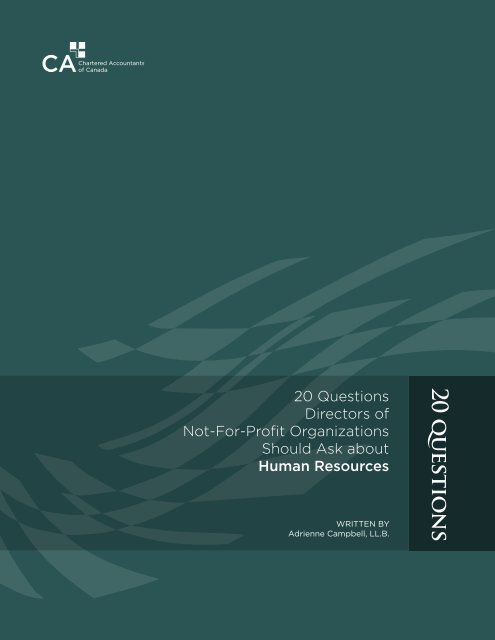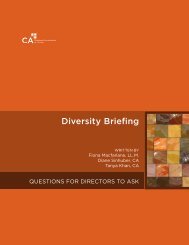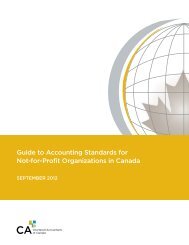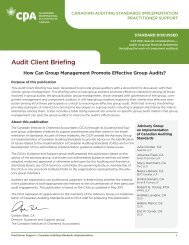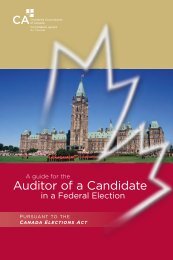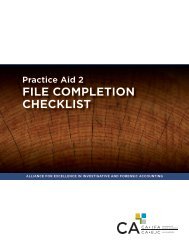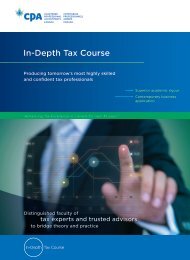2 0 questions - Canadian Institute of Chartered Accountants
2 0 questions - Canadian Institute of Chartered Accountants
2 0 questions - Canadian Institute of Chartered Accountants
You also want an ePaper? Increase the reach of your titles
YUMPU automatically turns print PDFs into web optimized ePapers that Google loves.
2. How should the board organize itselfto discharge these responsibilities?The board <strong>of</strong> directors provides strategic leadershipand governance over the operations <strong>of</strong> theorganization. However, due to the diversity <strong>of</strong> thenot-for-pr<strong>of</strong>it sector, the way in which the boardoperates and the degree to which directors areinvolved in the management <strong>of</strong> the organizationvaries.In smaller organizations, particularly those whichdon’t have a designated HR person on staff, boardmembers may be involved in management issues,including the recruitment, management, andcompensation <strong>of</strong> employees, contractors and volunteers.Directors may also be involved in makingdecisions about terminating those relationships. Inother organizations, these functions will be handledby the Executive Director and other staff, andthe board’s function is largely one <strong>of</strong> oversight.Regardless <strong>of</strong> the degree <strong>of</strong> involvement in theorganization’s internal HR practices, every board <strong>of</strong>directors has direct responsibility for the relationshipwith the Executive Director and the approval<strong>of</strong> overall human resources policies and practices.Some boards may choose to create a HumanResources and Compensation Committee (HRcommittee) to focus on the organization’s humanresources issues. The decision as to whether ornot to create a committee is one that must bemade by each board individually and will generallydepend on the size, scope and resources <strong>of</strong>the organization and the board.HR committees are <strong>of</strong>ten tasked with providingrecommendations to the board regardingthe recruitment and appointment <strong>of</strong> the ExecutiveDirector and the compensation philosophy<strong>of</strong> the organization. The committee may also bein charge <strong>of</strong> overseeing and approving, or actuallydeveloping and implementing, policies withrespect to recruitment, training, employee relations,health and safety, succession and talentmanagement, compensation, performance managementand benefits administration.Other organizations choose to address theseissues at the level <strong>of</strong> the full board. It is importantto recall that even when a human resourcescommittee is established, the board as a wholeretains overall responsibility. However theseissues are addressed, they should be clearly setout either in the mandate <strong>of</strong> the board or in theterms <strong>of</strong> reference <strong>of</strong> the committee. Responsibilityfor overseeing policies and practices relatingto volunteers may be addressed together with theresponsibility for paid workers or may be part <strong>of</strong>the responsibilities <strong>of</strong> a separate committee.When considering which directors should sit onan HR committee, or should be involved in HRdecisions taken by the full board, considerationshould be given to the following issues:• Independence – any directors who are alsomembers <strong>of</strong> management should not sit onan HR committee, nor should they take partin decisions relating to HR issues if they areaddressed by the board as a whole.• Conflicts <strong>of</strong> interest – directors should alsoavoid sitting on an HR committee or takingpart in decisions if they have a family memberor close friend employed by the organization.• Expertise/education – Human resources isa complex area and one that is continuallyevolving. Boards should endeavour to recruitdirectors with expertise in the area, andshould provide ongoing training and educationin the area <strong>of</strong> human resources to the HRcommittee or to the full board as appropriate.4
20 Questions Directors <strong>of</strong> Not-For-Pr<strong>of</strong>it OrganizationsShould Ask about Human ResourcesPART A — The ExecutiveDirector RelationshipThe Executive Director reports directly to theboard, and the board is responsible for all aspects<strong>of</strong> this relationship, which is arguably the mostimportant relationship in the organization.3. How does the board selectan Executive Director?One <strong>of</strong> the most important acts the board undertakesis the selection and hiring <strong>of</strong> the ExecutiveDirector. When it is time to select a new ED, someboards strike a special executive search committee,others delegate responsibility for the processto an existing HR committee, and others involvethe full board in the entire process.The use <strong>of</strong> a committee to take charge <strong>of</strong> thesearch process can be very effective, as the hiring<strong>of</strong> an Executive Director is a time-consumingprocess. At the end <strong>of</strong> the process, however, theresponsibility for selecting a new ED belongsto the full board, and although the committeeinvolved will make a recommendation, the finaldecision must be made by the board as a whole.The ED selection process must start with a thoroughanalysis <strong>of</strong> the organization’s strategy andits operating environment in order to determinewhat skills and experience the organization needsin the incoming ED. It should not be assumedthat the same skill set that the previous ED hadis necessarily the ideal one. Organizational needschange as organizations and their environmentsgrow and develop. A careful consideration <strong>of</strong>the organization’s current environment and itsfuture plans should inform the development <strong>of</strong>a leadership pr<strong>of</strong>ile which sets out the skills andexperience sought in the new ED.The board’s task when selecting an ED involvesdetermining how well an individual candidate’sstrengths and limitations fit with theorganization’s needs and requirements. Someorganizations opt to retain the services <strong>of</strong> apr<strong>of</strong>essional recruiter to assist in identifying candidates.Once the leadership pr<strong>of</strong>ile is in place and a list<strong>of</strong> potential candidates developed, the board (orcommittee) will then undertake the process <strong>of</strong>interviewing candidates and conducting backgroundchecks. The goal is to ensure that thecandidate has the stated education and backgroundand the necessary experience, and that heor she is a good fit with the mission and culture <strong>of</strong>the organization.While a human resources committee or searchcommittee may make its recommendation to theboard, the final hiring decision must be made bythe board as a whole. The board is then responsiblefor overseeing the communication <strong>of</strong> thedecision throughout the organization and to itsstakeholders, and mentoring the new ED as s/heassumes the role.For more iNFORmATion, plEASE seethe CICA publiCATion 20 QuestionsDirectors Should Ask about CEOSuccession.4. What is the board’s responsibilityfor managing and supportingthe Executive Director?The Executive Director reports directly to theboard <strong>of</strong> directors, and one <strong>of</strong> the board’s keyresponsibilities is mentoring the ED, managing hisor her performance, reviewing that performanceregularly against agreed-upon criteria, and contributingto the ED’s development.Directors should ensure that they are availableto support the Executive Director and serve asresources and advisors as necessary. The chair<strong>of</strong> the human resources committee (where oneexists) or chair <strong>of</strong> the board should be in contactwith the ED between board meetings as requiredto effectively manage the relationship. Some keyareas <strong>of</strong> the board-ED relationship are:Role clarity – The distribution <strong>of</strong> responsibilitiesbetween management and the board <strong>of</strong> directorsshould be clearly set out and adhered to.Established performance measures – The boardshould ensure that both the qualitative elements(behaviours) and quantitative measures (objectivesand deliverables) that are expected <strong>of</strong> theED are clear from the start <strong>of</strong> the relationship.Annual performance review – The performance<strong>of</strong> the Executive Director should be reviewedannually against the agreed-upon objectives and5
deliverables. Feedback from this review should becommunicated candidly with the Executive Director,and a plan developed for the following year.ED Development – Areas for improvement identifiedin the annual performance review canprovide the basis for a program <strong>of</strong> developmentfor the Executive Director. Changes in theorganization or its environment may also necessitateadditional training or development forthe ED. Just as employees and directors shouldreceive regular opportunities for training anddevelopment, so should the Executive Director.The human resources committee or the boardchair should take a lead role in ensuring that thisoccurs.In camera discussions – Every regular meeting <strong>of</strong>the board <strong>of</strong> directors should include an in camerasession, in which the board meets without theExecutive Director or other members <strong>of</strong> managementpresent. This is a valuable opportunity fordirectors to informally share their opinions andobservations regarding the ED’s performance,and to identify as early as possible areas in whichadditional coaching or support by the boardwould be helpful.Paying careful attention to the development <strong>of</strong>the Executive Director and being available to supportand mentor as necessary is important to thesatisfaction and successful performance <strong>of</strong> theED in his or her role and to the leadership <strong>of</strong> theorganization as a whole.5. How should the board address successionplanning for the Executive Director?Succession planning for the role <strong>of</strong> the ExecutiveDirector is a key responsibility <strong>of</strong> the board <strong>of</strong>directors but is one that is frequently neglected.The board <strong>of</strong> directors (or HR committee, whereone exists) should ensure that a robust successionplanning process is in place, and that the boardis prepared to cope with either a planned or anunplanned vacancy in the ED role.One key to success is monitoring promising internalcandidates to develop successors to the EDrole. The board should be satisfied that appropriatetalent development policies are in place inthe organization and should have in-depth discussionswith the ED regarding high-potentialstaff. The board should also conduct its ownassessment <strong>of</strong> the development <strong>of</strong> potential EDsuccessors. For this reason, it is vital that theboard have regular access to members <strong>of</strong> seniorstaff other than the executive director.The board should also be conscious <strong>of</strong> potentialcandidates for the leadership role from outside theorganization. Directors should periodically pooltheir knowledge about high-performing individualsin the particular sector or in the pr<strong>of</strong>essionalnetworks <strong>of</strong> directors in order to maintain awareness<strong>of</strong> potential sources <strong>of</strong> external talent.Planned succession – Refers to ED successionwhich is triggered by an anticipated event, suchas the planned retirement <strong>of</strong> the current ED. Toprepare for planned succession, the board shouldhave regular (annual) discussions with the EDregarding his or her performance and plans. An“evergreen” list <strong>of</strong> potential candidates (bothinternal and external) can be maintained so as tobe ready when the Executive Director announcesplans to leave the organization. The process bywhich a successor will be sought and the transfer<strong>of</strong> leadership handled should be agreed uponin advance in order for the process to transpiresmoothly.6
20 Questions Directors <strong>of</strong> Not-For-Pr<strong>of</strong>it OrganizationsShould Ask about Human ResourcesUnplanned succession – Refers to the sudden andunexpected departure or incapacitation <strong>of</strong> theED. This type <strong>of</strong> ED succession is much harder toplan for. However, the board can go a long waytowards preparing the organization for such atransition by maintaining awareness <strong>of</strong> potentialED successors (both internal and external to theorganization), and by having an emergency successionplan in place. Such a plan is generallydesigned to address the immediate needs <strong>of</strong> theorganization and may include a list <strong>of</strong> key functionsperformed by the Executive Director anda guide as to which key personnel (which mayinclude members <strong>of</strong> the board <strong>of</strong> directors) couldstep in and perform those functions on a temporarybasis. It might also set out the procedure forappointing an interim ED.For more iNFORmATion, see theCICA publiCATion 20 QuestionsDirectors Should Ask about CEOSuccession.6. What happens when the board decidesto replace the Executive Director?The decision to replace the Executive Director islikely the hardest one that a board <strong>of</strong> directorswill be called upon to make, and the one that willhave the greatest impact on the organization.While the board should not shy away from actingwhen it is clear that it is necessary to do so in thebest interests <strong>of</strong> the organization, it is not a decisionthat should be taken lightly.There are two different types <strong>of</strong> situations inwhich the board may be forced to considerreplacing the Executive Director.Sudden crisis <strong>of</strong> leadership – This refers to therare but serious situation in which a sudden,unexpected event forces the board to considerreplacing the ED. This could involve a situation inwhich the board becomes aware that the ExecutiveDirector has undertaken actions which areillegal or are otherwise so damaging to the organizationand its reputation that s/he must beremoved.Ongoing pattern <strong>of</strong> non-performance – Thisrefers to any number <strong>of</strong> different situations whichmay lead the board to determine, over a period<strong>of</strong> time, that the Executive Director is not thebest person for the job. This may involve a failureto live up to the agreed-upon standards <strong>of</strong>performance, inability to navigate the culture <strong>of</strong>the organization or lead effectively, or inability toexecute strategy or adapt to a changing environment.In neither situation should the board jump to aquick decision. Rather, the process undertakenshould be measured and transparent. That said,the board should also guard against inertia andthe temptation to “wait and see” when failure toact could place the organization at risk.In the case <strong>of</strong> sudden crisis <strong>of</strong> leadership, theboard will have to undertake a detailed investigationin order to determine the factual basis andveracity <strong>of</strong> any allegations. While the ExecutiveDirector might need to be temporarily placedon leave, a final decision must await a full understanding<strong>of</strong> the facts. In the case <strong>of</strong> an ongoingpattern <strong>of</strong> non-performance, the board shouldtake steps as soon as it becomes apparent thatthe ED is struggling in order to support and mentorthe ED in his or her role.When considering the replacement <strong>of</strong> the ExecutiveDirector, the board must take into accountissues including:• Legal obligations – The board should understandthe organization’s legal obligations asthe employer <strong>of</strong> the Executive Director andthe implications <strong>of</strong> removing the ED in terms<strong>of</strong> severance, retirement or other benefits,and potential legal liability.• ED succession – As discussed above, theprocess <strong>of</strong> selecting a new ED is a time-consumingone. The board should be prepared toundertake the process and steward the organizationthrough the period <strong>of</strong> transition.• Impact on the organization and its stakeholders– The board should consider theimpact <strong>of</strong> replacing the Executive Directorboth on the organization (including staff andvolunteers) and on other stakeholders such asfunders, donors and the public. A communicationsplan should be put in place to addressconcerns.For more iNFORmATion, see theCICA PubliCATion 20 QuestionsDirectors Should Ask about CrisisManagement.7
PART B — CompensationThe issue <strong>of</strong> compensation in the not-for-pr<strong>of</strong>itsector is receiving a great deal <strong>of</strong> attention, andthe board <strong>of</strong> directors has an important role toplay. The board is directly responsible for settingthe compensation <strong>of</strong> the Executive Director. Theboard is also responsible for overseeing the overallcompensation philosophy and practices <strong>of</strong> theorganization and determining what informationthe organization will disclose regarding compensation.If the organization has a pension plan, theboard will also have responsibilities as to the governance<strong>of</strong> the pension fund.7. How does the board approvethe compensation philosophyfor the organization?The board <strong>of</strong> directors oversees the compensationpractices <strong>of</strong> the entire organization by approvingthe organization’s compensation philosophy. Thecompensation philosophy articulates the organization’sgoals and desired outcomes, and the way inwhich the various elements <strong>of</strong> the organization’scompensation plan support those outcomes.Compensation varies widely across the notfor-pr<strong>of</strong>itsector. Smaller or less complexorganizations <strong>of</strong>ten spend very modestly oncompensation and their overall compensationprograms are straightforward and simpleto administer. At the other end <strong>of</strong> the spectrumare large organizations which spend a muchgreater amount on compensation and which utilizecompensation programs which are muchmore complex. While some organizations may berelatively unfettered in their ability to determineappropriate pay, others may be subject to restrictionsimposed by funders or others.An effective pay program should be designed toalign the interests <strong>of</strong> staff (particularly management)with the best interests <strong>of</strong> the organization,pay for performance, and help the organizationattract and retain talent.When reviewing compensation, the board’s overridingobjective should be to ensure that pay is:• effective – in that it achieves the desiredgoals,• responsible – in terms <strong>of</strong> value and cost, inthat it represents a wise use <strong>of</strong> the organization’sresources, and• defensible – in that it can be explained andjustified to stakeholders. 5Elements that the board may take into accountwhen reviewing the organization’s compensationphilosophy include:• Benchmarking – How do the organization’scompensation practices compare with those<strong>of</strong> similar organizations?• Internal equity – Does the compensation philosophyapply equally to all roles within theorganization and are similar roles compensatedin a similar manner?• Pay/performance linkages – Is compensationdesigned to motivate particular behaviours orreward achievement <strong>of</strong> specific goals?• Link to organizational strategy – Can thecompensation philosophy be clearly linked tothe organization’s strategy?• Incorporation <strong>of</strong> non-financial rewards –Does the compensation philosophy addressnon-monetary benefits such as working environment,flexible hours, and opportunities fordevelopment?The HR Council for the Nonpr<strong>of</strong>it Sector definescompensation as all <strong>of</strong> the rewards earned byemployees in return for their labour. It may bebroken down into direct financial compensationsuch as wages, salaries, bonuses and commissions;and indirect financial compensation such asbenefits, leaves, retirement plans, etc. 44Excellent material relating to compensation and otherelements <strong>of</strong> human resource stewardship in not-forpr<strong>of</strong>itorganizations is available in the online HR Toolkit<strong>of</strong> the HR Council for the Nonpr<strong>of</strong>it Sector at http://hrcouncil.ca/hr-toolkit/home.cfm. Discussion in thissection is based in part on that material.5Adapted from the CICA publication 20 QuestionsDirectors Should Ask about Executive Compensation(2 nd Ed).8
20 Questions Directors <strong>of</strong> Not-For-Pr<strong>of</strong>it OrganizationsShould Ask about Human ResourcesCompensation Red Flags:When reviewing the organization’s compensationphilosophy, the following indicators shouldtrigger extra review by the board:• Extensive use <strong>of</strong> discretion – in the setting<strong>of</strong> bonuses and other forms <strong>of</strong> compensation,or in the ability to override thecompensation guidelines.• Incenting undue risk-taking – pay structuresthat promise big payouts in returnfor achieving performance targets mayencourage excessive risk taking.• Undesirable risk exposures – pay elementsthat could put the organization at risk bytriggering large payouts (e.g., in the case <strong>of</strong>executive succession) or by damaging itsreputation in the eyes <strong>of</strong> stakeholders andthe public.8. How does the board set thecompensation <strong>of</strong> the Executive Director?In addition to approving the compensation philosophy<strong>of</strong> the entire organization, the board isresponsible for setting the compensation <strong>of</strong> theExecutive Director. While the board’s humanresources committee (if one exists) may domuch <strong>of</strong> the work and develop a recommendationregarding executive compensation, the finaldecision must be made by the full board. Largerorganizations may also consider the use <strong>of</strong> anindependent compensation consultant, althoughthis is not yet a common practice in the not-forpr<strong>of</strong>itsector.Elements that the board may consider whenreviewing the compensation <strong>of</strong> the ExecutiveDirector include:• Consistency with the overall compensationphilosophy – The ED’s compensation shouldfit within the same goals and guidelines thatgovern the compensation practices <strong>of</strong> theorganization as a whole.• External benchmarking and internal equity– The board may request information on howthe ED’s compensation compares with thatreceived by leaders <strong>of</strong> similar organizations,or how it relates to the compensation <strong>of</strong> otherswithin the organization.• Pay for performance – Where the ED’s compensationis tied to the achievement <strong>of</strong>specific goals, the board will need to reviewthe goals and ensure that they are appropriatein terms <strong>of</strong> achievability and also thatthere is an appropriate balance betweenshort-term and longer-term goals.• Talent retention – One <strong>of</strong> the main goals<strong>of</strong> executive compensation is to recruit andretain talented individuals to lead the organization.Direct monetary compensation shouldbe part <strong>of</strong> an overall package which may alsoinclude compensation in the form <strong>of</strong> healthand retirement benefits and non-financialbenefits such as working environment, pr<strong>of</strong>essionaldevelopment, etc. For organizationswhich are limited in their ability to providemonetary compensation, other types <strong>of</strong> benefitscan be an important means <strong>of</strong> recruitingand retaining leaders.Directors should ensure that they understand thedifferent elements <strong>of</strong> compensation packages,and that those obligations are properly capturedin the organization’s financial information.9. What is the board’s responsibilityfor the oversight <strong>of</strong> pensions?An employer is not required to provide any type<strong>of</strong> retirement savings program to its employees.However, many organizations choose to doso as part <strong>of</strong> their overall strategy to recruit andretain employees. There are two main types <strong>of</strong>employer-sponsored pension plans:• Defined benefit plan. The employer and/oremployee makes regular contributions overthe course <strong>of</strong> employment, and when theemployee has the requisite years <strong>of</strong> serviceand age to retire, the employee will receivea monthly benefit that is actuarially calculatedbased on years <strong>of</strong> service and earnings.The amount the employee receives is fixed,regardless <strong>of</strong> how well or poorly the pensioninvestment has performed, provided thatthe required funding levels have been maintained.• Defined contribution plan. This is similarto a group RRSP, in that the employee and/or employer contribute to the plan over theyears, but the amount the employee is entitledto receive on retirement is dependententirely on the performance <strong>of</strong> the fund. Theemployer may select a group <strong>of</strong> investmentfunds from which the employee can choose.9
Pensions must be registered in accordance withthe provincial pension legislation and any fundsmust be appropriately administered. Pensionrequirements and governing legislation are highlycomplex, and pension plans that are not properlymanaged can lead to substantial liability for boththe organization and the directors themselves.The board may discharge some <strong>of</strong> its responsibilityfor the oversight <strong>of</strong> pensions throughcommittees such as a pension committee, aninvestment committee, or the human resourcescommittee. However, although the performance<strong>of</strong> many functions related to the administrationand governance <strong>of</strong> pension funds may be delegatedto management, board committees orexternal administrators, the full board bears ultimateresponsibility.The board must ensure that the pension programaligns with the overall compensation and humanresources strategies, that it is properly managed,that the potential obligation to the organization isunderstood, and that there are funds in place tomeet that obligation.Directors <strong>of</strong> organizations with a pension plan areencouraged to seek further information on theiroversight obligations.For more iNFORmATion, see theCICA publiCATion 20 QuestionsDirectors Should Ask about theirRole in Pension Governance.10. What should the organization discloseabout its executive compensation?Currently the only requirement for public disclosure<strong>of</strong> executive salaries is that imposed by theCanada Revenue Agency, which requires certaindisclosures <strong>of</strong> registered charities.However, there is a great deal <strong>of</strong> public interestin the executive compensation practices <strong>of</strong> notfor-pr<strong>of</strong>itorganizations, and every organizationwill have to make its own determination as towhat information it wishes to disclose. Organizationswhich publish an annual report or makeinformation available to stakeholders on theirwebsite should give consideration to includinga description <strong>of</strong> the organization’s approach tocompensation, which should clearly explain howcompensation is set, who is responsible for determininglevels <strong>of</strong> compensation, what factors areconsidered and what the organization’s compensationphilosophy is designed to achieve.A clear statement which demonstrates that theboard <strong>of</strong> directors takes its responsibility forthe oversight <strong>of</strong> compensation seriously andapproaches the issue within a framework <strong>of</strong> carefullythought-out principles can help demonstrateto stakeholders the board’s effective stewardship<strong>of</strong> the organization’s resources, both human andfinancial.Larger organizations with significant compensationexpenses may wish to consider thecompensation disclosure obligations which applyto publicly-listed companies as a model.10
20 Questions Directors <strong>of</strong> Not-For-Pr<strong>of</strong>it OrganizationsShould Ask about Human ResourcesPART C — Oversight <strong>of</strong>Organizational Policiesand PracticesThe third element <strong>of</strong> the board’s responsibilitiesrelating to the human resources <strong>of</strong> the organizationis its role in overseeing the policies andpractices <strong>of</strong> the organization. Much <strong>of</strong> the work<strong>of</strong> the board in this area will be a supervisory oroversight function. There are some elements,however, such as the tone at the top, for whichthe board has primary responsibility.11. How does the board setthe tone at the top?The mandate <strong>of</strong> the board <strong>of</strong> directors includesensuring that the organization’s culture is characterizedby ethical practices and behaviour. Anorganization’s ethical climate is significantly influencedby its leadership. A term <strong>of</strong>ten used for thisinfluence is “tone at the top”. Directors set thetone at the top by ensuring that their own behaviourmeets the highest ethical standards, andrequiring the same <strong>of</strong> the Executive Director andother senior staff.The use <strong>of</strong> a code <strong>of</strong> conduct is a valuable toolfor influencing the culture and practices <strong>of</strong> theorganization. While the initial responsibility fordesigning a code <strong>of</strong> conduct rests with management,the board is responsible for reviewing andapproving the code and overseeing its implementationthroughout the organization.Codes <strong>of</strong> conduct are key vehicles for:• clearly articulating the organization’s values• helping introduce new employees to the organization’sstandards• attracting and retaining high-caliber employeesand volunteers• setting the boundaries <strong>of</strong> acceptable behaviour• informing contractors, suppliers and othersdoing business with the organization <strong>of</strong>expectations regarding acceptable behaviour• reducing the risk and costs <strong>of</strong> fraud, conflicts<strong>of</strong> interest and other ethical lapses; and• providing the basis for sanctions againstthose that deviate from the code.An effective code can enhance an organization’sreputation and contribute to its success. It alsoreinforces an organization’s culture <strong>of</strong> integrityby emphasizing each individual’s responsibility toobserve its principles and requirements. The code<strong>of</strong> conduct should apply not just to the staff <strong>of</strong>the organization but also to consultants and volunteers.Members <strong>of</strong> the board <strong>of</strong> directors are subjectto the code, and should ensure that their ownactions and those <strong>of</strong> the Executive Director areconsistent with the code.For more iNFORmATion, see theCICA publiCATion 20 QuestionsDirectors Should Ask aboutCodes <strong>of</strong> Conduct (2 nd ed).Screening <strong>of</strong> Employees and VolunteersAppropriate screening <strong>of</strong> both paid staff andvolunteers is extremely important and shouldbe included in the recruiting policies <strong>of</strong> all notfor-pr<strong>of</strong>itorganizations. Organizations thatprovide services to vulnerable populationsshould ensure that appropriate criminal backgroundchecks are required as a condition <strong>of</strong>working with the organization.12. How does the board oversee theorganization’s human resourcesstrategy and policies?When overseeing the organization’s HR policiesand practices, directors have a key strategic role,both in guiding and approving the organization’stalent recruitment and retention strategy, and inoverseeing the policy framework that establishesthe way the organization’s human capital will bemanaged.Talent Recruitment and RetentionThe board <strong>of</strong> directors is responsible for thelong-term sustainability <strong>of</strong> the organization. Havingthe appropriate human resources in place(whether paid or volunteer) is key to an organization’sability to survive and thrive. Recruiting andretaining talented employees can be particularlychallenging in the not-for-pr<strong>of</strong>it sector, as manyorganizations are not in a position to use high11
salaries to attract employees, and stock-basedincentives are not an option. Not-for-pr<strong>of</strong>it organizationsmay feel that they are at a disadvantageas compared to the private sector or governmentin recruiting employees.This challenge should not be viewed as simply astaffing or HR matter, but should be reviewed atthe board level with a view to the sustainability<strong>of</strong> the organization over time. The organizationshould have a clear strategy in place to recruit,develop and retain key employees. There aremany elements in addition to compensation whichcan appeal to potential employees, and organizationsshould focus on the diverse ways in whichthey can recruit and develop talented employees.Organizations that depend on volunteers shouldalso have a clear strategy to help them retain thevolunteers they have by providing a rewarding,enriching experience and to recruit new volunteersas necessary to support the organization’s activities.The organization’s overall human resourcesstrategy should encompass both paid and unpaidwork and should be approved at the board level.Oversight <strong>of</strong> Human Resources PoliciesOne key element which contributes to the retention<strong>of</strong> staff and employees is the cultivation <strong>of</strong>a positive work environment. The board playsan important role here in overseeing the policyframework <strong>of</strong> the organization. Leading organizationsdon’t wait for problems to develop orregulations to be passed, but rather take a proactiveapproach to developing policies that supportthe well-being <strong>of</strong> their employees and volunteers.Some key areas which must be addressed include:• diversity and inclusion• occupational health and safety• workplace bullying and harassment• accessibility• background checks and screeningPolicies should be available for all employees toaccess, and should address how any complaintswill be handled. There should be a clear chain <strong>of</strong>communication for any concerns, zero tolerancefor reprisal for bringing forth a complaint, and aproper investigation process. The board shouldreceive regular updates on complaints made andshould be immediately advised <strong>of</strong> any which cannotbe resolved by, or which involve, members <strong>of</strong>management.13. What relationships may existbetween the organization andindividuals providing services?To discharge their responsibility for overseeingthe organization’s human resources policies andpractices, directors need to understand the differentrelationships which may exist betweenthe organization and individuals providing services.The nature <strong>of</strong> the relationship can havesignificant implications for the person providingservices, the organization and the board. Thethree most common relationships are those <strong>of</strong>employee, independent contractor or consultant,and volunteer.Employee generally refers to a person who performswork for an employer in exchange formonetary compensation pursuant to a contract.Employees have protections and organizationshave specific obligations in relation to employeesunder employment standards and other legislation,which will be discussed further below.Independent contractors provide services to theorganization for a fee. The relationship an organizationhas with an independent contractor is acommercial relationship similar to those it wouldhave with other suppliers. It is not an employmentrelationship, and the organization generally doesnot have the same types <strong>of</strong> obligations that existtowards employees.The line between an employee and an independentcontractor can <strong>of</strong>ten be blurred. In somecases, organizations may enter into “independentcontracts” with individuals who then provide servicesthat may look very much like the services<strong>of</strong>fered by employees. Courts have set out a number<strong>of</strong> tests for determining whether someone isan employee or an independent contractor. 66Additionally, courts have also found there can be anothercategory <strong>of</strong> relationship, known as the dependentcontractor. This is a contractor who is so dependenton the relationship with the organization thatcourts are prepared to find that notice <strong>of</strong> termination<strong>of</strong> that relationship is required, much like the noticerequired to terminate an employee.12
20 Questions Directors <strong>of</strong> Not-For-Pr<strong>of</strong>it OrganizationsShould Ask about Human ResourcesContractorSpecific work that needs to be completed in specifictimeframeServices not part <strong>of</strong> core business <strong>of</strong> organizationHow, when and where services are provided negotiatedbetween parties or at sole discretion <strong>of</strong>contractorPayment on basis <strong>of</strong> fee for servicesContractor provides same or similar services toother organizationsContractor is known as having expertise andknows how to provide the servicesVolunteers are those who choose to give theirtime to an organization with the understandingthat they will not be compensated for the servicesprovided. These relationships are also not subjectto the same rules and obligations that govern theemployment relationship.The line between employee and volunteer mayalso be blurred. For example, someone maybe employed part time for an organization andreceive compensation for that work, but may alsowish to volunteer free time towards the organization,for which there is no compensation.14. Why is accurate classificationand documentation <strong>of</strong>relationships important?The obligations <strong>of</strong> an organization to individualsproviding services will depend upon whetherthose individuals are employees, independentcontractors or volunteers. The board <strong>of</strong> directorsis responsible for overseeing these relationshipsas well as the organization’s compliancewith the law and as such directors should satisfythemselves that relationships are appropriatelyclassified and that there is documentation whichsupports that classification and makes the rightsand obligations <strong>of</strong> the organization and the individualclear.Organizations have substantial obligations regardingtheir employees. They must withhold andmake remittances for taxes, Employment Insurancepremiums, workers compensation, provincialhealth premiums, and Canada/Quebec Pensionplan. Employers must pay minimum wage and providepaid public holidays to their employees. AnyEmployeeWork done over indefinite or set period <strong>of</strong> time(fixed term contract)Services likely to be part <strong>of</strong> or related to core business<strong>of</strong> organizationHow, when and where services are provided determinedand supervised by employerPayment by way <strong>of</strong> salary, commission, bonus,benefits, overtime, vacation pay, etc.Employee generally cannot provide same servicesto competitorsEmployer can provide training in how to do work ifnecessaryhours worked by eligible employees in excess <strong>of</strong>the mandated daily or weekly limits must be paidat overtime rates. Employees must be providednotice <strong>of</strong> termination as required by law.By contrast, volunteers and independent contractorsare not by law entitled to notice <strong>of</strong>termination, unless this is specifically included intheir contract. Additionally, the organization doesnot make statutory deductions or remit employertaxes on behalf <strong>of</strong> volunteers and independentcontractors. Volunteers and independent contractorsare not protected under the organization’sworkers compensation coverage and are not entitledto overtime, leaves <strong>of</strong> absence or paid publicholidays.One significant risk to the organization stemmingfrom its management <strong>of</strong> human resources is thatif an organization wrongly classifies an individual’swork as something other than employment andthere is a subsequent finding (e.g., by a court orthe Canada Revenue Agency) that the relationshipis in fact in the nature <strong>of</strong> employment, theorganization could be found liable for not complyingwith the appropriate legislation.For example, if someone is working full timehours, and then is asked to volunteer time to furtherthe organization’s interests, those volunteeractivities could later be found to be employment,in which case the organization would be liable forany unpaid wages and overtime for those additionalhours, as well as the applicable employertaxes. This is particularly likely when the volunteeractivities are the same or similar to the activitiesperformed as part <strong>of</strong> employment and wherethere is an expectation that the employee willundertake the volunteer activities.13
Example 1: Nafisah is employed as a paid marketingdirector for an organization. She works40 hours a week in this role. She agrees tovolunteer her time on weekends to attend atvarious events where she hands out brochuresabout the organization. There is no specificrequirement that she do this, but she feels itis expected. As the volunteer work is directlyrelated to what she does as an employee, it isvery likely Nafisah would be entitled to be paidfor that additional work, including any requiredovertime.Example 2: Marcel works as a marketing director<strong>of</strong> a national pr<strong>of</strong>essional association. Theassociation is having a neighbourhood fun fairas a fund raising event to raise money for thelocal children’s hospital. The charity has norelation to the business <strong>of</strong> the association. Marcelvolunteers to come and paint faces at theevent. In that case the work is unrelated bothto Marcel’s job and to the core business <strong>of</strong> theassociation, and would be properly characterizedas voluntary and thus unpaid.Similarly, where an individual is employed as anindependent contractor and the relationship isterminated, a court could find that the relationshipwas actually one <strong>of</strong> employment, therebytriggering notice and severance obligations.In addition, fines and interest could be leviedagainst the organization for failure to withhold therequired employer taxes and remit employer premiumson behalf <strong>of</strong> the individual for the duration<strong>of</strong> the relationship.As a result, it is extremely important that relationshipswith service providers be properlydocumented in writing and signed by both theorganization and the service provider, with termsthat clearly outline each party’s rights and obligations.Where an individual provides services inmore than one capacity, the organization mustdocument the difference in the roles and keepappropriate records with respect to each activity.Checklist for DocumentingContractual RelationshipsContracts can be as complex or simple as theorganization wishes. They can be by way <strong>of</strong> letter,or by way <strong>of</strong> a more legalistic documentthat looks like a formal contract. Regardless <strong>of</strong>the format, the agreement should address:• nature <strong>of</strong> the position• reporting relationship• duration• nature <strong>of</strong> services to be provided• compensation and benefits• required notice <strong>of</strong> termination• provisions relating to confidentiality anduse <strong>of</strong> personal informationIssues Relating to Employees15. What is the board’s responsibilityfor compliance with employmentlaws and regulations?The details <strong>of</strong> the organization’s compliancewith applicable laws and legislation are theresponsibility <strong>of</strong> management. However, theboard <strong>of</strong> directors is responsible for overseeingcompliance. As such, directors should have anunderstanding <strong>of</strong> the organization’s legal obligationsso as to be able to satisfy themselves thatthose obligations are in fact being met.There are numerous legislative minimum requirementsemployers must meet or exceed withregard to how they compensate and treat theiremployees. Some <strong>of</strong> these provisions are similaracross all provinces and territories, while otherprovinces may have their own unique provisionswith regard to specific areas <strong>of</strong> employment.14
20 Questions Directors <strong>of</strong> Not-For-Pr<strong>of</strong>it OrganizationsShould Ask about Human ResourcesLaws and Regulations Governingan Employment Relationship1. Employment Standards legislation governsminimum wages, vacation time and vacationpay, public holidays, hours <strong>of</strong> work, overtimepay, meals and rest breaks, leaves <strong>of</strong>absence, record keeping, and notice <strong>of</strong> termination.The provisions differ by province.2. Human Rights legislation prohibits discriminationand harassment in employmentbased on any defined prohibited grounds,and protects against reprisal for making anycomplaint. The provisions differ by province.3. Workplace Health and Safety legislationrequires employers to take precautions andprovide appropriate training to maintain asafe and healthy workplace and ensure thehealth and safety <strong>of</strong> its workers. The provisionsdiffer by province.4. Workers Compensation legislation requiresthat certain employers pay premiums andparticipate in statutory no-fault insurancescheme that compensates workers who sufferfrom a work-related illness or injury. Theprovisions differ by province.5. Income tax legislation outlines the necessarydeductions and withholdings forincome tax and Canada Pension Plan. Thereis federal and provincial income tax legislation.6. Employment Insurance legislation outlinesthe necessary forms to be provided ontermination <strong>of</strong> employment and the circumstancesin which employees may be allowedor denied employment insurance benefits.This is federal legislation and is the sameacross Canada (except for Quebec).7. Pension legislation sets out the frameworkunder which organizations that <strong>of</strong>ferretirement programs to their workers mustoperate. The provisions differ by province.8. Immigration Act outlines the basis uponwhich foreign workers can be employed.This is federal legislation and is the sameacross Canada.There are a number <strong>of</strong> issues directors should beaware <strong>of</strong>.Entitlement to work in Canada – Employees mustbe <strong>Canadian</strong> citizens, permanent residents, orhold a valid work permit.Source deductions – Employers are requiredto make deductions from an employee’s wagesfor federal and provincial income tax, EmploymentInsurance premiums and Canada PensionPlan/Quebec Pension Plan contributions and t<strong>of</strong>orward these monies to the appropriate governmentalauthority.Employment records – Each province sets outcertain specific information which an employermust record and the length <strong>of</strong> time for whichrecords must be kept. Additionally, each provincehas specific requirements for when and how toprovide written information to an employee.Employment standards – Provincial employmentstandards laws set out the minimum requirementsfor wages, vacation time and pay, public holidays,hours <strong>of</strong> work, overtime pay, breaks, leaves<strong>of</strong> absence and notice <strong>of</strong> termination. Employeescannot ‘contract out’ <strong>of</strong> these provisions andcontracts which purport to exclude these requirementswill not be enforced by the courts. Certaintypes <strong>of</strong> employees (managers, pr<strong>of</strong>essionals)may be excluded from some <strong>of</strong> the provisions.Human rights legislation• Discrimination – Discrimination is prohibitedthroughout Canada on the grounds <strong>of</strong>15
ancestry, place <strong>of</strong> origin, colour, ethnic origin,citizenship, creed, sex, sexual orientation,age, marital status, family status and disability.Some provinces have additional grounds<strong>of</strong> prohibited discrimination, such as politicalbelief, language and social condition (economicstatus). Discrimination is prohibited inall aspects <strong>of</strong> employment, including hiring,compensation, promotion, lay-<strong>of</strong>f, discipline ortermination.In some provinces, certain religious, philanthropic,educational, fraternal or socialorganizations that are primarily engaged inserving the interests <strong>of</strong> persons with certainattributes may be able to discriminate in limitedrespects, such as with regard to language, sexualorientation or religion. These organizationsmay only discriminate where it is reasonableto do so because <strong>of</strong> the nature <strong>of</strong> the employment.Additionally, the organization mustshow that otherwise discriminatory practice isnecessary, as well as legitimately and directlyconnected to the nature <strong>of</strong> the employment.• Harassment – Harassment (including sexualharassment) is also prohibited. Harassmentessentially involves a course <strong>of</strong> vexatiouscomment or conduct that is known or oughtto be known to be unwelcome. Where an isolatedincident is serious enough on its own, itwill also be found to be harassment.• Accessibility – Employers have an obligationto ensure that their employment practices andworkplaces are accessible and do not discriminateagainst candidates or employees with adisability, be it physical or psychological. 7Occupational Health and Safety – An employeris required to ensure the health and safety <strong>of</strong> itsworkers by taking every reasonable precaution tomaintain a safe and healthy workplace. Provinciallaws set out the employer’s obligation to providetraining, develop health and safety programs andpost health and safety policies in the workplace.Depending on its size, an organization may be7In Ontario, this obligation is even more extensive inlight <strong>of</strong> the Accessibility for Ontarians with DisabilitiesAct, 2005, which will require all organizations toensure accessibility for all persons with disabilities inthe areas <strong>of</strong> customer service, employment, buildings,information and communication, and transportation.This will include training employees on appropriateways to provide goods and services to, and communicatewith, employees and customers with disabilities.required to have a joint health and safety committeemade up <strong>of</strong> workers and management.• Workplace bullying and violence – In Ontarioand British Columbia, workplace harassmentand violence are specifically covered underoccupational health and safety laws. Employersare required to have specific policies andprograms in place and to conduct regularassessments <strong>of</strong> the risk <strong>of</strong> violence in theirworkplace.Worker’s Compensation – This statutory no-faultinsurance scheme compensates workers whosuffer from a work-related illness or injury. Membershipis mandatory for certain employers andrequires payment <strong>of</strong> premiums.16. What are the potential liabilities <strong>of</strong>directors with respect to employees?Organizations which fail to meet their obligationsto employees can face investigations, lawsuits,fines and other penalties, which are levied againstthe organization. In addition, there are some lawsunder which directors could be held personallyliable for failing to fulfill their responsibilities.Directors <strong>of</strong> not-for-pr<strong>of</strong>it organizations are notheld to any lesser standard than directors <strong>of</strong> forpr<strong>of</strong>itcorporations.Income Tax Act – The Income Tax Act providesthat where an organization fails to withhold and/or remit employee taxes on behalf <strong>of</strong> its employees,directors may be liable for a portion <strong>of</strong> thoseamounts, plus penalties and interest.Courts will consider the actions taken (or nottaken) by directors. In one income tax case,the directors <strong>of</strong> an organization were liable forpayroll deductions that they knew had beenwithheld from employees but had not beenremitted by the organization to the Crown.The court found that, as the failure to remitthe taxes was known by the directors and wasallowed to continue for nearly a year, they hadnot exercised the degree <strong>of</strong> care and diligenceexpected <strong>of</strong> directors and were therefore personallyliable.Occupational Health and Safety – A failure toimplement basic health and safety precautionscould result in charges being laid under either theCriminal Code <strong>of</strong> Canada or the provincial occupationalhealth and safety legislation.16
20 Questions Directors <strong>of</strong> Not-For-Pr<strong>of</strong>it OrganizationsShould Ask about Human ResourcesEmployment Standards – Directors’ liability for theorganization’s failure to comply with employmentobligations differs by province, but may includeliability for unpaid wages and vacation pay.Safeguard:• Some organizations require the ExecutiveDirector to certify in writing to the boardthe payment <strong>of</strong> all wages, source deductions,tax remittances and pension planobligations. This may be done monthly,quarterly or annually.• If there is a concern that the organizationis trending towards financial difficulties,boards may consider the creation <strong>of</strong> a designatedtrust account to segregate payrollamounts, source deductions, and accruedvacation pay.Pensions – Negligent administration <strong>of</strong> a pensionplan can lead to fines under pension legislation orcivil lawsuits.Criminal and other <strong>of</strong>fences – Boards that authorize,permit or instruct the organization to commit<strong>of</strong>fences or break laws may be found guilty <strong>of</strong><strong>of</strong>fences under the Criminal Code or other legislation.In light <strong>of</strong> the potential liabilities, it is vital thatdirectors understand the organization’s obligationswith respect to employees and other serviceproviders. The board must satisfy itself that theExecutive Director or anyone else responsible formanaging human resources fulfills their dutiesand that the organization is in compliance with itsobligations.Appropriate indemnities and insurance can provideprotection for some <strong>of</strong> the above liabilities.For more information, see the CICA publicationLiability Indemnification and Insurance forDirectors <strong>of</strong> Not-for-Pr<strong>of</strong>it Organizations.17. What should the board <strong>of</strong>directors know about terminatingemployment relationships?When an organization chooses to terminate itsrelationship with an employee, there are particularissues that directors should be aware <strong>of</strong>. Althoughthe termination <strong>of</strong> employee relationships is theresponsibility <strong>of</strong> the Executive Director, the EDmay seek advice from the board <strong>of</strong> directors. Inaddition, the board may find itself in the position<strong>of</strong> having to terminate the relationship with theExecutive Director. As a result, directors shouldhave an understanding <strong>of</strong> the organization’s obligations.Termination for cause – When an employeeengages in conduct that can be legally justifiedas cause for termination, an employer has theright to terminate the employment relationshipimmediately with no notice or payment in lieu <strong>of</strong>notice. To constitute cause for termination, theconduct must constitute a significant breach <strong>of</strong>the employee’s contract. For example, seriousmisconduct or performance problems which havebeen previously addressed and documented bymanagement can constitute just cause. An organizationshould always obtain legal advice beforemoving forward with a decision to terminate anemployee on a “with cause” basis.Termination without cause – When an organizationwishes to terminate an employmentrelationship in the absence <strong>of</strong> behaviour constituting“just cause”, the organization must providethe employee with appropriate advance notice,in writing. Alternatively, the organization can providepayment for the amount equal to what theemployee would otherwise have earned over thatnotice period, known as “pay in lieu <strong>of</strong> notice”.The required amount <strong>of</strong> notice may be set outin the employment contract, or else determinedbased on legal guidelines which take into considerationthe employee’s age, years <strong>of</strong> service,salary and position. These rules may vary by province.In a unionized setting, the required notice isset out in the collective agreement.A terminated employee can file a complaint underthe employment standards legislation, labourrelations act, or human rights legislation dependingon the nature <strong>of</strong> the complaint and whetheror not the employee is unionized. If a court ortribunal finds that the employer did not providesufficient notice or otherwise did not meet itslegal obligations towards the employee, a monetaryamount, interest and possibly reinstatementcan be ordered. In cases where the terminationis conducted in a manner that shows bad faithon the part <strong>of</strong> the employer, there may be additionaldamages awarded against the organizationby way <strong>of</strong> compensation for mental distress orpunitive damages to punish the employer for thatconduct.Costs related to these types <strong>of</strong> claims can be significantso it is very important that any decision17
to terminate employment be made carefully andonly after a review <strong>of</strong> the facts leading up to thatdecision. Any <strong>of</strong>fer <strong>of</strong> payment in excess <strong>of</strong> therequired notice and severance amounts shouldalways be on the condition that the employeeagrees to waive all future claims against the organization.While directors may have some personal liabilityfor unpaid wages and vacation pay, they arenot personally liable for any common law noticeor wrongful dismissal damages unless it can beshown that a director has acted improperly andoutside his or her duties.18. How is the employment relationshipdifferent in a unionized environment?In a unionized workplace, the relationshipbetween the organization and its employees willlargely be governed by the terms and conditionsthat are negotiated between the organization andthe union in a collective agreement. The collectiveagreement replaces individual employmentcontracts, and the organization cannot enter intodeals or arrangements directly with its unionizedemployees. The terms and conditions <strong>of</strong> the collectiveagreement can be complicated and canlead to disputes over application or interpretation.The collective agreement will be negotiated on aregular basis between the parties, and whethereither the union or the employer is prepared tomake any concessions will depend on their relativebargaining strength and appetite to face astrike or lockout if the parties cannot agree.The minimum standards as established underthe employment standards legislation, workerscompensation scheme, occupational health andsafety requirements, and human rights provisionsstill apply and cannot be ousted by the collectiveagreement, but disputes are addressed eitherbetween the employer and union or by the provinciallabour relations board, not by courts orother tribunals. For the most part, an organizationcannot terminate the employment <strong>of</strong> its unionizedemployees without just cause.For fuRTHER iNFORmATion onunions, plEASE see Appendix 1.Issues Relating to IndependentContractors/Consultants19. How should the board overseethe organization’s use <strong>of</strong>independent contractors?The use <strong>of</strong> independent contractors or consultantscan be an effective way for not-for-pr<strong>of</strong>itorganizations to access specialized skills andexpertise, but also brings the potential for risks tothe organization if relationships are not properlymanaged. The board <strong>of</strong> directors plays an importantrole in ensuring that appropriate policies andpractices are in place regarding the organization’suse <strong>of</strong> contractors.Procurement Policies – The issue <strong>of</strong> procurementpolicies has received a great deal <strong>of</strong> attentionin the broader public sector, and the lessonslearned there can be valuable to all not-for-pr<strong>of</strong>itorganizations. Boards <strong>of</strong> directors should satisfythemselves that:• the organization has clear written policiesaround the use <strong>of</strong> consultants;• assignments are well defined and properlyjustified before consultants are engaged;• procurement practices are fair, open andtransparent;• individual contracts set clear ceiling prices;• payments to consultants are tied to specificdeliverables; and• performance <strong>of</strong> consultants is carefullyreviewed and managed.The use <strong>of</strong> sole-source contracts and follow-onassignments to extend existing contracts withoutproper review should be avoided.Documentation – As discussed earlier in thisdocument, appropriate classification and documentation<strong>of</strong> the organization’s relationships withservice providers is important. Relationships withindependent contractors should be governed bycontracts which clearly set out the nature <strong>of</strong> therelationship as well as the rights and duties <strong>of</strong> allparties.18
20 Questions Directors <strong>of</strong> Not-For-Pr<strong>of</strong>it OrganizationsShould Ask about Human ResourcesDocumenting the Relationship with anIndependent ContractorSince these agreements are not employmentagreements, the contract should not use termsthat are similar to terms used in an employmentagreement.• The nature <strong>of</strong> the services should bedefined.• Payment should be defined as fee forservices rather than compensation, andshould be subject to the provision <strong>of</strong>appropriate invoices, with the appropriateGST/HST charged.• Confidentiality and non-solicitationclauses should be included, but non-competitionclauses should be avoided.• A contractor should not be entitled togroup insurance or other benefits providedto the organization’s employees.• There should be express wording regardingwho is responsible for the payment <strong>of</strong>taxes and the contractor should indemnifythe organization for any employer taxesthat may be found to have been due andnot paid.• It should be clear that the contractor willprovide the necessary tools to do thework.• If possible, it should be left to the contractorto address when, where and how thework will actually be done.• There should be provisions outlining theamount <strong>of</strong> notice for termination <strong>of</strong> thecontract.Issues Relating to Volunteers20. How should the board oversee theorganization’s use <strong>of</strong> volunteers?Volunteer Recruitment and Engagement – Theprocess <strong>of</strong> seeking out and recruiting volunteers,as well as keeping them engaged and ensuringtheir continued participation is ongoing and iscritical to the organization.Volunteer Screening – An organization should bevery careful about whom it selects or approves toprovide volunteer services. Although not employees,these individuals may be able or expected tohold themselves out as representative or agents<strong>of</strong> the organization. As a result, the organizationcould find itself responsible for wrongfulacts done by the volunteer. Depending on thenature <strong>of</strong> the activity being performed and thepopulation with which the organization works,background checks, including screening for criminalrecords, should be performed for volunteers.Job Description – There should be clear descriptions<strong>of</strong> the roles and responsibilities <strong>of</strong> volunteerswith the organization. These will vary dependingon the role played by the volunteer. Some volunteersparticipate at a single event, whereas othersare involved in a long-term commitment to theorganization. Volunteer job descriptions shouldmake it clear that volunteers receive no compensationand are under no legal obligation tocontinue volunteering for the organization.Contracts/Volunteer Agreements – It is a goodpractice to require volunteers to sign a documentacknowledging that they understand their rolewithin the organization as being that <strong>of</strong> a volunteerand not an employee. In some cases, it maybe prudent to obtain signed releases and waivers<strong>of</strong> liability. Many organizations also require volunteersto sign codes <strong>of</strong> conduct and confidentialityagreements.Training, Supervision and Management – Volunteersshould receive training, supervision andmanagement to ensure that they are performingtheir duties in a safe and effective mannerto the benefit <strong>of</strong> the organization. Appropriatesupervision and guidance will also help make theexperience more rewarding for volunteers.The board <strong>of</strong> directors is also responsible foroverseeing the organization’s use <strong>of</strong> volunteers.This may be done by the board as a whole,through a human resources committee, orthrough a separate committee focused on volunteerengagement and management. Similar to thesituation with employees and contractors, directorsshould satisfy themselves that appropriatepolicies and documentation are in place.19
Appendix 1 —The Employment Relationshipin a Unionized EnvironmentUnion OrganizationThe unionization <strong>of</strong> a workplace begins with a union conducting an organizing drive to get employeesto sign union cards or otherwise indicate support for joining the union. If enough cards are signed, theunion will apply to the Labour Board to be certified as the bargaining agent for a group <strong>of</strong> employees.Depending on the province, the employees may be given an opportunity to vote by way <strong>of</strong> secret balloton whether or not they want to be represented by the union. If the majority <strong>of</strong> employees who votechoose to be represented by the union, all the employees in the designated bargaining unit will beunionized.During a union organizing drive, the employer is not allowed to make any changes to the terms andconditions <strong>of</strong> employment outside changes in the normal course. There are very strict rules aroundwhat an employer can and cannot do or say during a union organizing campaign. In some provinces,if an employer breaches those rules, the Labour Board may order that a union be certified as the bargainingagent for the employees even if the union was unable to demonstrate the required level <strong>of</strong>employee support.Bargaining & Good FaithOnce the union is certified, the union will be the exclusive bargaining agent for the employees, and theunion and employer will enter into negotiation <strong>of</strong> a collective agreement setting out the terms and conditions<strong>of</strong> employment. The parties have a duty to bargain in good faith with the union. The employeris required to meet with the union and make every effort to conclude a collective agreement. If anemployer and a union cannot agree to the terms <strong>of</strong> a collective agreement after a certain period <strong>of</strong>time, the union is legally entitled to stage a strike and an arbitrator will be appointed to either help theparties reach agreement, or impose an agreement on them.Grievances and ArbitrationsOnce the collective agreement is in place, any negotiation about changes to terms and conditions <strong>of</strong>employment will be with the union. If a unionized employee disagrees with discipline that has beenimposed by the employer, the employee can complain to the union, which will take it up with theemployer. An employer cannot terminate a unionized employee without just cause by simply payingnotice. If the parties cannot reach a resolution, the matter will proceed to a grievance hearing before athird party. This is in the nature <strong>of</strong> a mini-hearing with evidence and legal argument. Alternatively, theunion and employer may disagree about the interpretation <strong>of</strong> a provision in a collective agreement andhow it should be applied. In these situations, if the parties cannot resolve the matter between them, thedispute will be argued and decided at an arbitration hearing. These types <strong>of</strong> proceedings can be costlyand time consuming.An organization that does not have experience and expertise in dealing with union matters shouldalways consult the appropriate legal advice before taking any steps with regard to the employmentrelationship with its unionized employees.20
20 Questions Directors <strong>of</strong> Not-For-Pr<strong>of</strong>it OrganizationsShould Ask about Human ResourcesWhere to find more informationCICA Publications on GovernanceThe Not-for-Pr<strong>of</strong>it Director SeriesNPO 20 Questions Series20 Questions Directors <strong>of</strong> Not-for-Pr<strong>of</strong>it Organizations Should Askabout Board Recruitment, Development and Assessment20 Questions Directors <strong>of</strong> Not-for-Pr<strong>of</strong>it Organizations Should Ask about Fiduciary Duty20 Questions Directors <strong>of</strong> Not-for-Pr<strong>of</strong>it Organizations Should Ask about Governance20 Questions Directors <strong>of</strong> Not-for-Pr<strong>of</strong>it Organizations Should Ask about Risk20 Questions Directors <strong>of</strong> Not-for-Pr<strong>of</strong>it Organizations Should Ask about Strategy and PlanningLiability Indemnification and Insurance for Directors <strong>of</strong> Not-for-Pr<strong>of</strong>it OrganizationsNPO Director AlertsPandemic Preparation and Response — <strong>questions</strong> for directors to askIncreasing Public Scrutiny <strong>of</strong> Not-for-Pr<strong>of</strong>it Organizations — <strong>questions</strong> for directors to askNew rules for charities’ fundraising expenses and program spending — <strong>questions</strong> for directors to askOther Publications<strong>Accountants</strong> on Board — A guide to becoming a director <strong>of</strong> a not-for-pr<strong>of</strong>it organizationThe Director SeriesThe 20 Questions Series20 Questions Directors and Audit Committees Should Ask about IFRS Conversions (Revised ed)20 Questions Directors Should Ask about Building a Board20 Questions Directors Should Ask about CEO Succession20 Questions Directors Should Ask about Codes <strong>of</strong> Conduct (2 nd ed)20 Questions Directors Should Ask about Crisis Management20 Questions Directors Should Ask about Crown Corporation Governance20 Questions Directors Should Ask about Director Compensation20 Questions Directors Should Ask about Directors’ and Officers’ Liability Indemnification and Insurance20 Questions Directors Should Ask about Executive Compensation20 Questions Directors Should Ask about Governance Assessments20 Questions Directors Should Ask about Governance Committees20 Questions Directors Should Ask about Internal Audit (2 nd ed)20 Questions Directors Should Ask about IT20 Questions Directors Should Ask about Management’s Discussion and Analysis (2 nd ed)20 Questions Directors Should Ask about Responding to Allegations <strong>of</strong> Corporate Wrongdoing21
20 Questions Directors Should Ask about Risk (2 nd ed)20 Questions Directors Should Ask about the Role <strong>of</strong> the HumanResources and Compensation Committee20 Questions Directors Should Ask about their Role in Pension Governance20 Questions Directors Should Ask about Special Committees20 Questions Directors Should Ask about Strategy (2 nd ed)Director BriefingsClimate Change Briefing — Questions for Directors to AskLong-term Performance Briefing — Questions for Directors to AskControlled Companies Briefing — Questions for Directors to AskDiversity Briefing — Questions for Directors to AskDirector AlertsFraud Risk in Difficult Economic Times — <strong>questions</strong> for directors to askHuman Resource and Compensation Issues during the Financial Crisis — <strong>questions</strong> for directors to askThe Global Financial Meltdown — <strong>questions</strong> for directors to askExecutive Compensation Disclosure — <strong>questions</strong> directors should askThe ABCP Liquidity Crunch — <strong>questions</strong> directors should askNew <strong>Canadian</strong> Auditing Standards — <strong>questions</strong> for directors to askThe CFO SeriesDeciding to Go Public: What CFOs Need to KnowFinancial Aspects <strong>of</strong> Governance: What Boards Should Expect from CFOsHow CFOs are Adapting to Today’s RealitiesIFRS Conversions: What CFOs Need to Know and DoRisk Management: What Boards Should Expect from CFOsStrategic Planning: What Boards Should Expect from CFOsAdditional Information on Human Resourcesin the Nonpr<strong>of</strong>it SectorHR Council for the Nonpr<strong>of</strong>it Sector — www.hrcouncil.ca22
About the authorAdrienne Campbell, LL.B.Partner, Miller ThomsonAdrienne Campbell is a member <strong>of</strong> the Labourand Employment Group at Miller Thomson. Shehas extensive experience in both private practiceand as in-house counsel. She has provided legaladvice and strategic counsel to multiple businesschannels including those in the banking andretail sectors, on a variety <strong>of</strong> national employeerelations, employment and labour matters.Ms. Campbell’s background allows her to providepractical, business-oriented advice to federallyand provincially regulated clients in both thepr<strong>of</strong>it and not-for-pr<strong>of</strong>it sectors in areas such as<strong>of</strong>fer letters, executive employment contracts,positive employee relations, progressivediscipline, terminations, human rights, attendancemanagement issues, drafting <strong>of</strong> human resourcepolicies, and the employment implications<strong>of</strong> corporate reorganizations. In addition,Adrienne acts as employer counsel with regardto employment disputes before tribunals andadjudicators in both the provincial and federalsector, as well as wrongful dismissal proceedingsbefore the court.Ms. Campbell has presented numerous lecturesand seminars, and provided training to humanresource and business leaders on a variety <strong>of</strong>issues both internally and at events sponsoredby the Retail Conference <strong>of</strong> Canada, Kenexa,Conference Board <strong>of</strong> Canada Shepell-FGI,<strong>Canadian</strong> Bar Association and Infonex.When not at work, Ms. Campbell enjoys dining out(and therefore running), playing golf, and secretlylistening to her teenage daughter’s music.
01 02 03 04 FnL1 OTYCOTIDMS41DElTQk4gQmFyY29kZQ0xSzZCRlktTFpFUkoyMklXAE1RSkcFMTEuCEZpbmVMaW5lHUtSWFdIQlBDRC1UUDBBLTU1Mzg1LTU2Mi0wRA==04 0116ISBN-13: 978-1-55385-562-020 QuestionsDirectors <strong>of</strong>Not-For-Pr<strong>of</strong>it OrganizationsShould Ask aboutHuman Resources9781553 85562004000068277 Wellington Street WestToronto, ON CanadaM5V 3H2416.977.3222WWW.cica.ca


